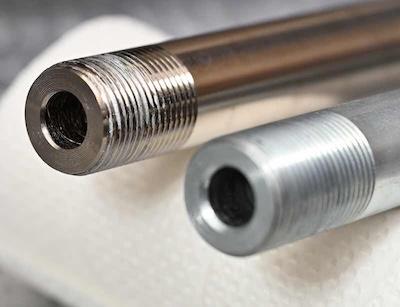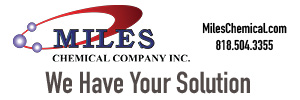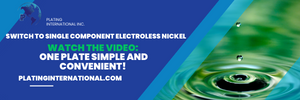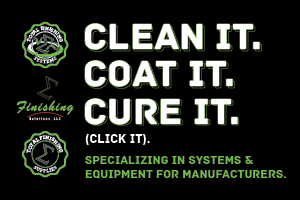We talked with Joe Zabielski from Ronatec about the new Paladin high-phos electroless nickel chemistry, which the company states offers outstanding corrosion protection and hardness.
Zabielski says Paladin has passed salt spray tests up to 8500 hours and has an as-plated hardness equivalent to a mid-phos bath.
 Joe ZabielskiJoe Zabielski: Paladin is a novel high-phos electroless nickel process. It operates at a plating rate of four to six-tenths an hour. However, one of its truly unique characteristics is that it imbues extraordinary corrosion resistance. A typical high-phos will fail NSS around 500 to 1,000 hours. We have over 8,500 hours at this point, and our testing continues (now at 8500 hours)
Joe ZabielskiJoe Zabielski: Paladin is a novel high-phos electroless nickel process. It operates at a plating rate of four to six-tenths an hour. However, one of its truly unique characteristics is that it imbues extraordinary corrosion resistance. A typical high-phos will fail NSS around 500 to 1,000 hours. We have over 8,500 hours at this point, and our testing continues (now at 8500 hours)
Furthermore, we've been able to address the hardness issues that one has with a typical high-phos process. You must bake a high-phos to achieve a certain hardness. This process runs at the same hardness as a mid-phos electroless nickel bath. To put that in perspective, a high-phos has a knoop hardness, generally speaking, of 450 to 525. A mid-phos has a knoop hardness of 550 to about 650. Our Paladin process runs from 570 to about 620, which puts us firmly in mid-phos territory with exceptional corrosion resistance.
TP: Did it surprise you guys when you started seeing those numbers? Did you have a clue that this is what you're going to be getting out of that?
JZ: I was very impressed when we started to blow past 3000 hours. The performance got more exceptional and is now included in this very day. Moreover, we decided to perform all testing at a NADCAP-accredited facility. We used a third-party lab, so these are not internal results. All testing is valid and could be submitted as part of an applicator’s testing regime.
TP: And this is a one-component system?
JZ: It is a one-component makeup with a 1-to-1 replenishment. It operates at a standard high speed as high-phos would.
TP: And it's a self-adjusting pH, so it's easy to use.
JZ: It is. You'll see no change in the method of use compared to a standard high-speed high-phos.
TP: Paladin provides about 10 to 15 percent more corrosion resistance. Can you give us a little background on why that is?
JZ: It has more like, I would say, 7 to 15-times corrosion resistance improvement. It's an order of magnitude at that point.
TP: Take a little back to how long you guys have been working on this project.
JZ: From concept to production, which we are engaging in right now, I'd give it about a year and a half of development time. We are entering the manufacturing phase, and the product launch will be in Q1 of 2025. The process will be available for purchase in January.
 TP: Is this something you've heard from some of your customers asking? Or how did this all come about coming up with this product idea?
TP: Is this something you've heard from some of your customers asking? Or how did this all come about coming up with this product idea?
JZ: Firstly, it came about from certain requirements from the oil and gas industry. They wanted longer service life for their tooling. That is where we started with this. We found different applications that could benefit from this corrosion resistance, particularly in the aerospace connector industry. Often, you need to use duplex coatings, such as electroless nickel with cadmium, electroless nickel with zinc nickel, and hexavalent chromate. This can potentially eliminate some of those extra coatings and the hexavalent chromium. We found applications in the semiconductor industry, where some semiconductor tools are exposed to a highly corrosive gaseous environment. This should be able to protect those harsh environments as well.
TP: You say you were testing at a Nadcap facility. Were there any concerns with that?
JZ: The nice thing is they were courteous enough to let me audit their facility before I submitted any samples. I went into that facility with 100% confidence. They've also assisted me in getting Boeing approval for our mid-phos electroless nickel. That’s the RoHS EN 1000 from our previous interview.
TP: The Paladin name; I'm just curious about that. What is that?
JZ: A definition of Paladin is any determined advocate or defender of a noble cause. Now, the noble cause in this case, we decided, was a noble coating. Part of the definition of a noble coating is that it protects the metal being coated from harsh environments where corrosion is possible.
TP: 7,500 hours is huge, and the 7 to 15-time corrosion is great, but what goals did you set for yourself with Paladin? What was your goal, and what were you shooting for?
JZ: Originally 2,000 to 3,000 hours, but we've exceeded all expectations. The hardness numbers are also a huge advantage. Achieving the hardness of a mid-phos with no post-plate treatment is quite a feat when using high-phos chemistry, considering that high-phos is a superior coating in every way except for hardness and wear resistance, which often correlates.
 Rontaec has been using a knight in armor imagery as it promotes Paladin.TP: I'm sure you've been talking to a couple of finishers in the industry and telling them about this coming down the pike. What have been some of their reactions to this?
Rontaec has been using a knight in armor imagery as it promotes Paladin.TP: I'm sure you've been talking to a couple of finishers in the industry and telling them about this coming down the pike. What have been some of their reactions to this?
JZ: Thus far, we've run it in one NADCAP-accredited plating facility. This is where we ran the vast majority of our sample panels. So far as ease of use, it operated like their typical high-phos. My customers are very interested in elevated corrosion. Moving forward, I will have to perform a lot of outreach to the OEMs to get this spec in. We’re playing the long game here. Customers are ready for this process.
TP: How quickly can you get this spec’d in?
JZ: There is a very rigorous procedure to getting a product on the QPL of a specification. So it's just going to be standard testing. The time frame will vary by OEM and industry.
TP: As you said, Ronatec spent over a year working in the labs on this. Was there a point where you thought, “We're going to be hitting our mark on this thing?”
JZ: It's very interesting because we started to pass key metrics very early on. It was a very natural progress with few hiccups, to be honest.
TP: Is that about average for what you would do with product designing this and testing it out and such? Is that the average time?
JZ: I can't speak to that, but the number of hours and months we've been in the salt spray chamber is a key driver for why it's taken so long.
TP: Paladin would be available to the oil and gas industry in the first quarter of 2025 because that's one of the harshest environments. It is perfect for that market, especially if no one's in it. And it seems like it's pretty easy to use, with it being the one component.
JZ: Absolutely. The other market that has a great home is the connector market due to its potential ability to replace nickel-cadmium and nickel / zinc-nickel for MIL-DTL-38999. We’ll also push hard to apply its application to semiconductor manufacturing tools.
Visit www.Ronatec.us
Performance Data – latest results in bold
HPEN -
- NSS = 500-1000 hours
- Hardness = 450 - 525 HK as plated
- Wear resistance = 22 - 24 mg per 1000 cycles as plated
MPEN -
- NSS = 100 hours
- Hardness = 550 - 650 HK as plated
- Wear resistance = 14 - 17 mg per 1000 cycles as plated
LPEN -
- NSS = NO
- Hardness = 775 HK as plated
- Wear resistance = 7 - 12 mg per 1000 cycles
Paladin Shield -
- NSS = 8500 hours
- Hardness = 570 - 620 HK as plated
- Wear resistance = 9.8 mg per 1000 cycles































